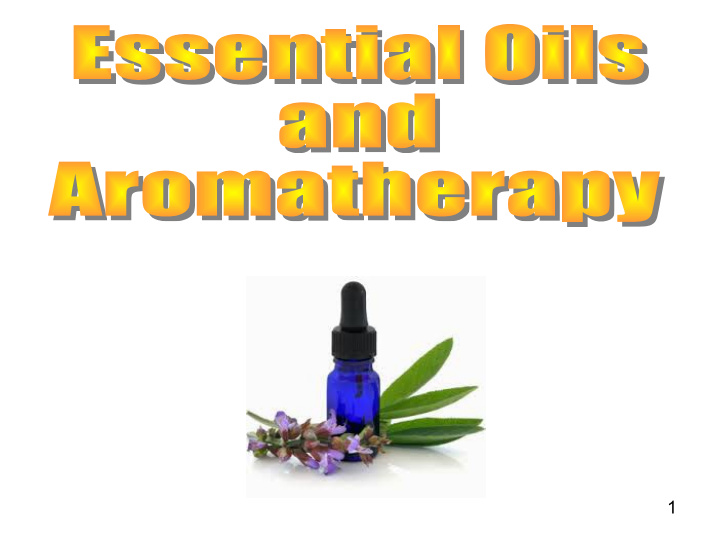



1
Methods of Extracting or Obtaining Essential Oils The most common method for extracting essential oils is using steam distillation. Solvents are often used in extracting oils that are waxy The most expensive method is using CO2 which does not heat up the plant and preserves maximum aromatics and properties of the plant. Plant resins can also be obtained directly from the plant that exudes resins. Index Card Testing A way to test an essential oil is by Index testing. The process of Index testing is taking a drop of oil and placing it on an unmarked Index card (not paper). Wait until the essential oil completely drys, about 30 minutes. There should be nothing visible left on the index card. If there is no “oil ring” left behind, then there should be no carrier oil 2 (olive oil, jojoba oil, vegetable oil, etc.) that has been used to extend and dilute the essential oil.
Rules For Safe Use Of Essential Oils Essential oils: are very concentrated and flammable so there are important considerations to keep in mind. The website http://www.aromaweb.com/articles/safety.asp has many details and lists oils for each of these items: • Do not use undiluted (“neat”) essential oils directly on the skin (there are exceptions) as sensitivity can develop. Use carrier oils. • Allergic reactions are possible, so when using for the first time, test on a small area of skin. • Some oils should be avoided with certain health conditions such as pregnancy, asthma, epilepsy, etc • Use small amounts of oil. • Some oils are phototoxic meaning they cause problems or can damage skin when exposed to UVA rays. • Some oils are hazardous. • Keep your oils away from children. • Do not take essential oils internally without a practitioner or advanced knowledge of safe usage. 3
Clove & Cinnamon Essential Oils: Clove and cinnamon essential oils are the greatest anti-oxidant density. Two drops of essential oil of clove and four drops of cinnamon oil have the anti- oxidant capacity of 5lbs of carrots, 2.5 quarts of carrot juice, 10 oranges, 20 ounces of orange juice, 2.5 lbs of beets, 1 pint of beet juice, 4 cups of raspberries or 2.5 cups of blueberries. Cinnamon is known for its ability to enhance insulin receptor site activity. This is especially important because it reduces the amount of insulin in the bloodstream. This strongly contributes to stable blood sugar, enhanced fat metabolism and decreased cellular inflammation (12). 4
5
Carrier Oils • Essential oils evaporate and have a concentrated aroma. • Carrier oils, are pressed from fatty seeds, nuts, etc, generally are odorless and do not evaporate. Carrier oils can go rancid over time, but essential oils do not, but rather they “oxidize” and lose their therapeutic benefits . This is the reason that small dark bottles are used to package essential oils. • Only buy carrier oils that have been “cold pressed” and the ones that contain tocopherols (Vitamin E) generally have an extended shelf life. Some common carrier oils are: • Sweet almond • Olive, • Apricot kernel • Sesame • Avocado • Sunflower • Grapeseed • Coconut • Jojoba Some absorb into the skin faster than others. NEAT means to “apply an essential oil to your skin undiluted.” meaning that you would not add a carrier oil. 6
7
8
9
Blend of: Wintergreen, camphor, peppermint, Blue tansy, German chamomile, Helichrysm, Osmanthus Blend of: Laurel leaf, peppermint, eucalyptus, melaleuca, lemon, ravensara 10
11
12
13
EE (Essene Essence) Oil • Used topically for muscles and joints • A “soothing to the heart” pain reliever • Brings relief to aches, sprains, headaches, congestion, bruises and spasms. • Stomach pain, toothache, foot pain WO China Healing Oil • Effective for sore throat, bleeding gums • Wounds, abrasions, cuts, bruises • Anti diarrheal • Food poisoning, gastro-intestinal • Parasites and ringworm, etc 14
Bug Sprays Peppermint bug spray (repels spiders and flies) – very simple: Put 8 drops of peppermint oil for each cup of water in a spray bottle. Wellness Mama Essential Oil Bug Spray Ingredients: • Essential oils: choose from Citronella, Clove, Lemongrass, Rosemary, Tea Tree, Cajeput, Eucalyptus, Cedar, Catnip, Lavender, Mint • Natural Witch Hazel • Distilled or boiled Water • Vegetable glycerin (optional) Instructions: 1.Fill spray bottle (I used 8 ounce) 1/2 full with distilled or boiled water 2.Add witch hazel to fill almost to the top 3.Add 1/2 tsp vegetable glycerin if using 4.Add 30-50 drops of essential oils to desired scent. The more oils you use, the stronger the spray will be. My personal favorite mix is: Rosemary, Clove, Cajeput, Lavender, Cinnamon and Eucalyptus… it works great and smells good too! 15
Thank You and Make Sense of the Scents 16
Recommend
More recommend